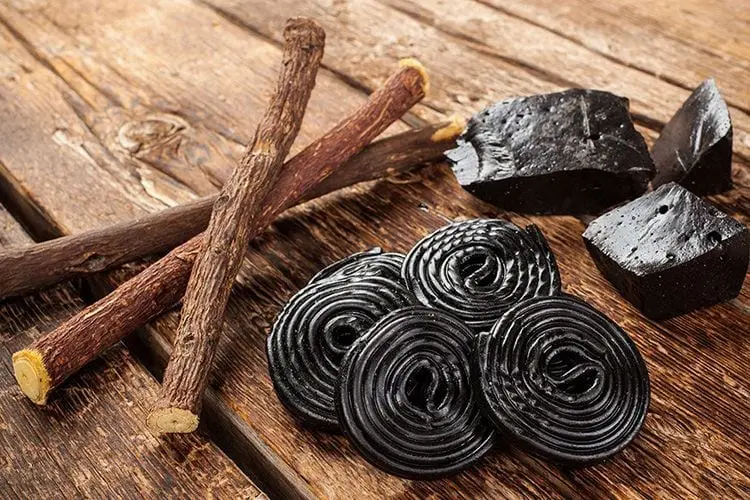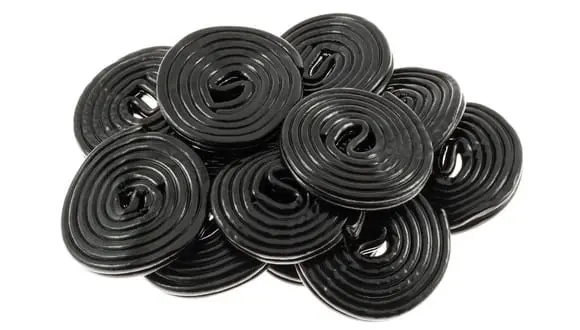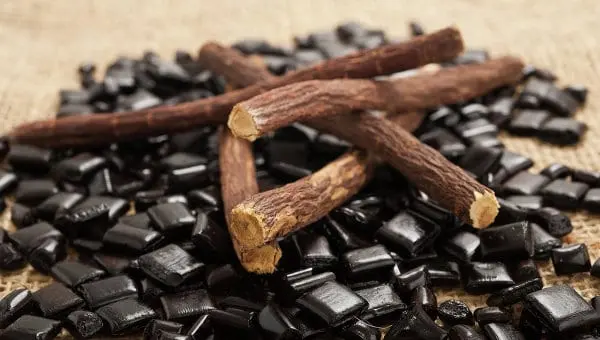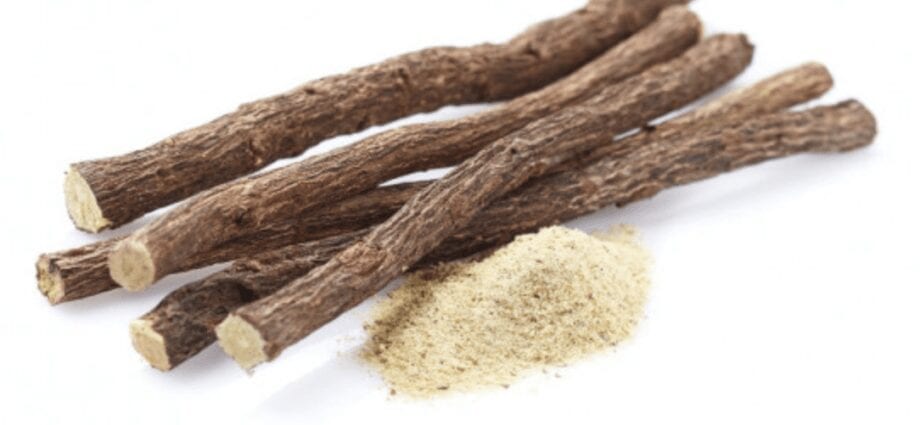Contents
Description
In the confectionery departments of supermarkets, it is difficult not to notice the black sweets: licorice (Lakritsi) and salmiakki (Salmiakki). The Finns are very fond of them, and many Russians do too.
The valuable medicinal and nutritional properties of plants roots have long been known. Traditional Tibetan and Chinese medicine uses this plant extensively. As noted in historical publications, licorice comes from the Mediterranean, Asia Minor and Central Asia.
She traveled along the Great Silk Road to China, and then to Tibet. It took root there well and spread further – beyond Central Asia, appeared in Western Europe and America, where it had not grown before.
People were attracted by the sweet root: glycyrrhizin, which is part of it, is fifty times sweeter than sugar. The peeled roots were savored with great pleasure, because sugar was rare. Until recently, this custom was preserved in North America, and in Northern Europe, licorice candies are favorite treats of adults and children.

One of the greatest military leaders of antiquity, Alexander the Great, provided his troops with supplies of licorice during the campaigns due to the excellent thirst-quenching properties of this plant.
Licorice candy
Licorice got into sweets at the beginning of the 18th century, when the first sweets with licorice root extract were created in the English county of Yorkshire. Today, the confectionery industry produces dozens, if not hundreds, of types of licorice candies for every taste. Consumers are offered lollipops, granules, straws, sticks. There is even licorice spaghetti – black, like some snail-rolled licorice pastilles.
This variety of licorice owes primarily to the Finns – fans of licorice candies. They also figured out how to get an extract from the peeled, soaked and boiled licorice root, which they called licorice. And later they learned to make not only sweets from this extract, but also cakes, pies, cookies, ice cream, pickles, compotes, cocktails and even vodka.
Particularly popular is the so-called meter liquorice – candy in the form of a string cut into pieces. Licorice is often added to another unique Finnish product called salmiakki.
To those who do not understand these products, they seem very similar to licorice. The name of the sweets is predetermined by the fact that they contain salammoniac (ammonium chloride), known to most of us as ammonia, which gives the products their characteristic flavor.
Licorice sweets are made and consumed by the Netherlands, Italians, Danes, and the British, Germans, and Americans also appreciated them. In some countries, for example, in Great Britain, liquorice is liked to be consumed sweet, and in the Scandinavian countries and the Netherlands – salty. These candies have a variety of looks – both as black tubes rolled up by a snail, and as various animal figures.

Drop is a Danish word for hundreds of varieties of liquorice sweets. Favorites include sweets in the form of animal figures, in particular, sweet ones in the shape of cats, salty ones in the shape of small fish covered with salt.
Licorice candy – what are they made of?
The main ingredient is licorice root, the very plant from which the famous natural cough syrup is made in Russia. Licorice sweets have a salty and sour taste. In Finland they are produced in various shapes and sometimes filled with fillings.
Particularly popular is the so-called “meter liquorice”: the candy looks like a cord cut into pieces. In addition to licorice, the delicacy includes wheat flour, water, sugar, syrup, charcoal, flavorings, dyes and preservatives are also added.
The benefits of licorice
Licorice root contains a huge amount of vitamins and useful biologically active natural compounds. Licorice is used medicinally for diseases of the upper respiratory tract, gastritis and ulcers, allergic dermatitis and diabetes mellitus. Official medicine is not against the use of such candies for the prevention of flu and colds.
Use in medicine

In medicine, licorice preparations are used for various diseases of the respiratory tract as an anti-inflammatory, emollient and expectorant agent, and as drugs that regulate water-salt metabolism. Apparently, everyone knows pharmaceutical licorice syrups for coughs.
Licorice preparations are used in the form of an extract of dry or thick syrup, root extract, root powder, breast elixir and a number of other drugs that treat inflammatory diseases, bronchial asthma, eczema. Licorice powder is also used in pharmaceutical practice to improve the taste and smell of drugs.
In folk medicine, a decoction of licorice root is used as an expectorant and emollient for coughs, bronchitis, whooping cough, asthma, pulmonary tuberculosis, as a mild laxative and diuretic.
Official medicine is not against the use of such drugs for prevention and treatment. But, again, not everyone can be treated with them.
And licorice is also readily used in cooking – in the manufacture of marinades, compotes, jelly, salting fish, for aromatizing hot drinks.
Contraindications
However, licorice-based products are prohibited for pregnant and lactating women. Salted liquorice candies are not recommended for people with a water-salt balance, kidney disease and hypertension. In addition, other substances that make up the plant can give a severe allergic reaction.
What is Salmiakki
Salmiakki is another strange Finnish product. Out of habit, it can taste like licorice. But not for the Finns: they always recognize a black treat with a special sweet-salty taste. The name “salmiakki” is due to the large amount of salammoniac (NH4CI ammonium chloride) they contain, which is also known as ammonia. It gives a characteristic aroma to the product.

The famous Finnish entrepreneur and pastry chef Karl Fazer is considered the founder of this unusual delicacy. It was Fazer who launched the small diamond-shaped plates in 1897. From these plates came the concept of salmiak as a food product, because the rhombus in Finnish sounds like “salmiakki”.
At first the word was a trademark, but then it became a common name for all such sweets. Over the past hundred years, the range of salmiak products has expanded significantly. In Finnish shops you can find not only sweets, but also salmiak ice cream and salmiak liqueur.
In 1997, a special society of consumers of this delicacy was registered. Every year its members hold two obligatory events: in January they choose the best product, and in the summer they hold a traditional Salmiakovo picnic.
Besides Finland, salmiak has gained popularity in Norway, Sweden, Denmark and Iceland. In other European countries, the sweetness has not found much recognition, with the exception of the Netherlands. In this regard, Holland is even jokingly called “the sixth northern country in Europe.”
Salmiak – benefit or harm?
Salmiakki usually contains salt and often licorice. If consumed extensively and frequently, the product may be harmful to people suffering from, for example, indigestion or cardiovascular disease. However, doctors usually very rarely prescribe to completely abandon such a treat. With moderate consumption, it will not bring harm.
How to make licorice candy at home

Licorice sweets are also made in Ukraine, but they are not so popular with us, and many people know only lollipops with licorice for coughs.
In the meantime, these candies can be made at home. Children will definitely love making such sweets. Mine, in any case, immediately set about making them as soon as they learned about such a possibility.
I read one of the recipes for making homemade liquorice sweets on the Best Recipes for a Family website.
Therefore, you need to take:
- licorice powder – 1/4 cup
- anise powder (flavoring) – a quarter cup
- sugar – one glass
- juice – half a glass
- corn syrup – half a cup
- water – a third of a glass.
Boil sweet caramel mass from corn syrup, sugar, water and juice. Pour liquorice and anise powders into it, mix and bring to a boil again. Then remove the viscous mass from the fire and pour it into silicone molds for sweets.
When the candies have set, sprinkle with potato or cornstarch and place in a glass jar. Admire your own products a little and start eating.
By the way, you can plant unpretentious licorice at home or in your summer cottage. The main thing is that the soil in this place is not very wet or not too sandy, which will not retain moisture.










